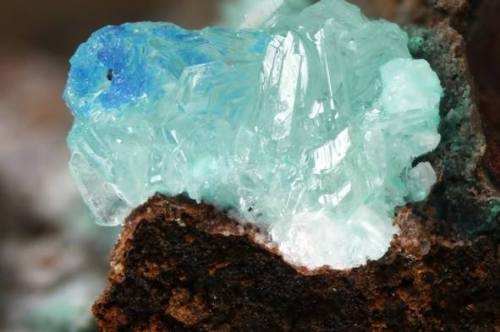Minerals of the Anthropocene One of my first posts here was on the topic of mineral evolution (see h
Minerals of the AnthropoceneOne of my first posts here was on the topic of mineral evolution (see http://bit.ly/2m0bUJS), discussing how the range of minerals on earth has expanded through time and co-evolved with life over the long aeons of the Earth. Now a new chapter in this long history is being written, that of minerals created by man, with their appearance one of the possible contenders for the stratigraphic Golden Spike that traditionally accompanies the declaration of a new geological era (which is being discussed by the international Commission of Stratigraphy as we speak).At least 208 out of 5,200 minerals are either entirely man made, or mostly so, with the natural versions being very rare and born in uncommon geological circumstances. Examples include minerals formed on tin ingots in shipwrecks, museum drawers (where minerals placed within react with chemicals in the wood to form unique compositions) and abandoned mines, many of which have only appeared in the last two centuries. If you read my original post on mineral evolution, one can see that like in biological evolution, long periods of relative stability are followed by brief ones of rapid diversification, suggesting that punctuated equilibrium applies on many levels, and this rapid burst of creativity of new minerals in processes mediated by human activity is unique in planetary history.Many more manmade ‘minerals’ (ie not recognised as such but crystalline) are thought to be unrecognised as yet, and many unique human creations such as doped laser crystals such as Yttrium Aluminium Garnet coloured by rare earth elements or the diamond imitant cubic zirconia have no natural equivalent, and never will, though the ones we have made will survive for geological timespans.Other unique crystals form in concretes, the remnants of which will definitely be in the marker layer that our civilisation leaves behind after its inevitable eventual demise in vast quantities. Mine fires, ore dumps and even the shoring timbers have proved host to the formation of new and unknown minerals, and mine tunnels with their distinctive temperature and humidity are environments with no real equivalent in nature. No one has even looked in electronic waste dumps to see what might be forming out of all these rotting plastics and unusual metals. Imagine what kind of weird lens in a sedimentary rock something like the Smithsonian mineral gallery would make, or even my personal rock stash in my garage (I already amuse myself by speculating about what some excavators of the future might end up thinking)…It looks like the greatest burst of mineral evolution since the Great Oxygenation Event of the Proterozoic (which doubled the number of minerals from around 2000 between 2.5 billion and 650 million years ago) has been brought about by intelligent life, playing with matter…LozImage credit: 1 The blue fine-grained crust of chalconatronite is sometimes found on ancient Egyptian bronze artefacts: rruff.info/chalconatronite Andersonite from Hillside Mine, Bozarth Mesa, Baghdad. Photograph: Courtesy of Trevor Boyd/Causeway MineralsAbhurite, an aggregate of tan-coloured platy crystals from the wreck of the SS Cheerful, 14 miles NNW of St. Ives, rruff.info/abhurite. Simonkolleite found on a copper mining artifact in Rowley mine, Maricopa County, Arizona: RRUFFhttp://bit.ly/2lsbnj8http://bit.ly/2mIQ3YoOriginal paper, paywall access: http://bit.ly/2lXSMyH -- source link
Tumblr Blog : the-earth-story.com
#geology#mineral#anthropocene#mineralogy#chemistry#minerals#mineral evolution



